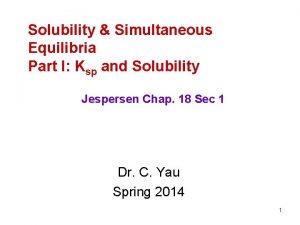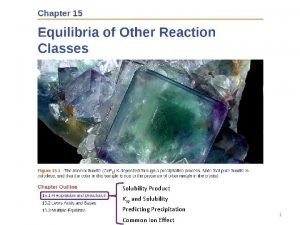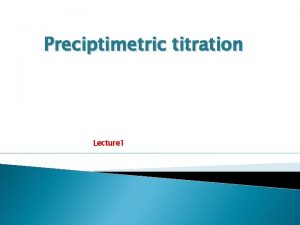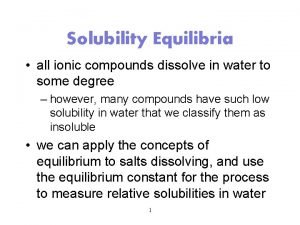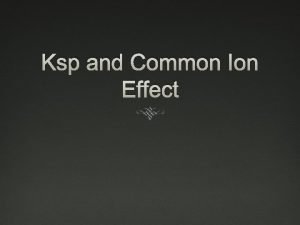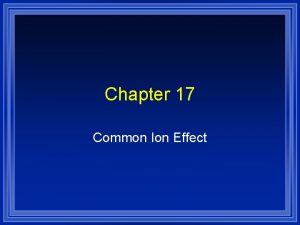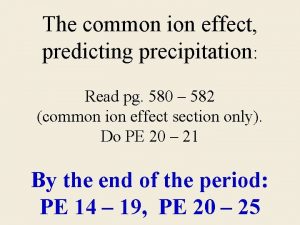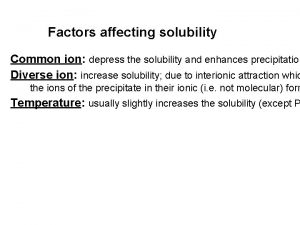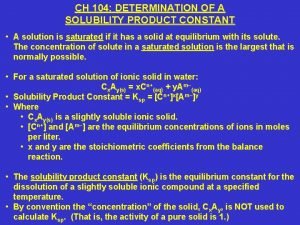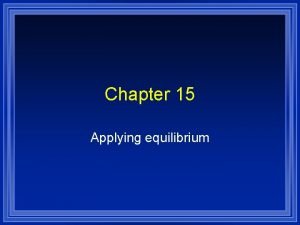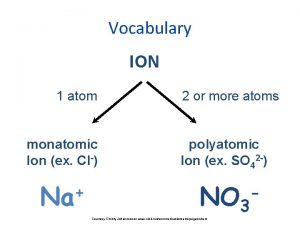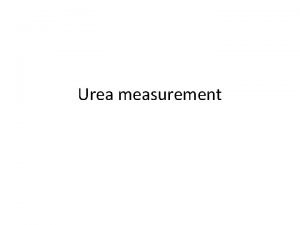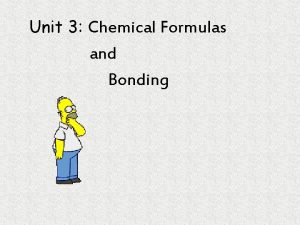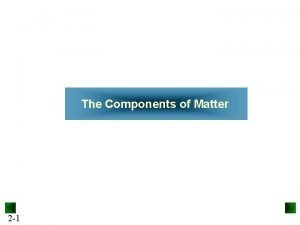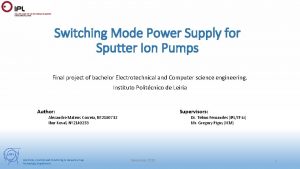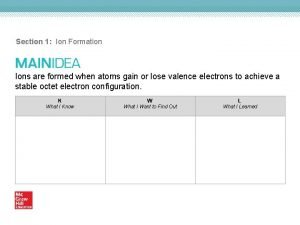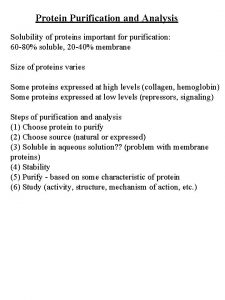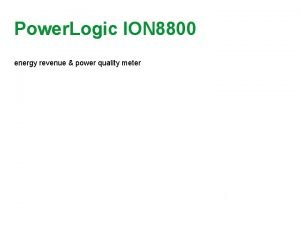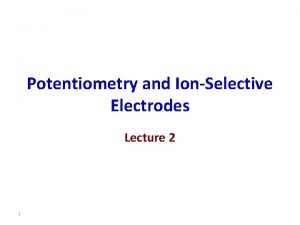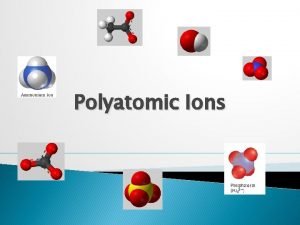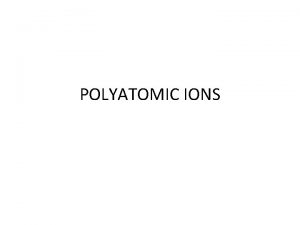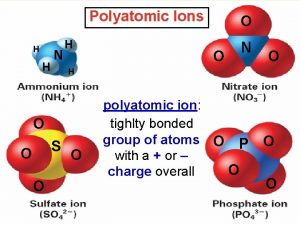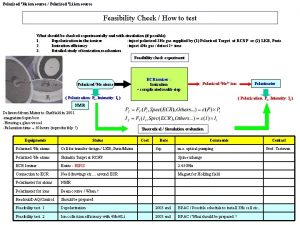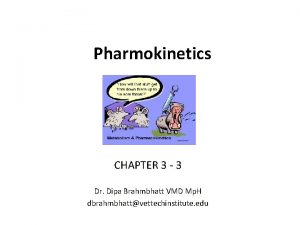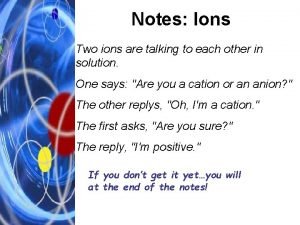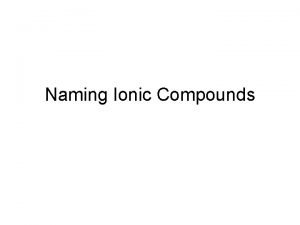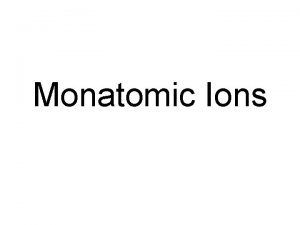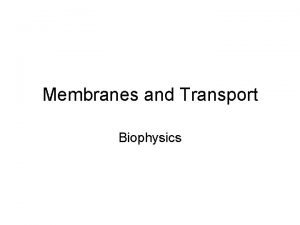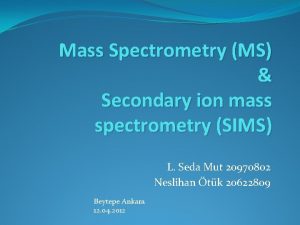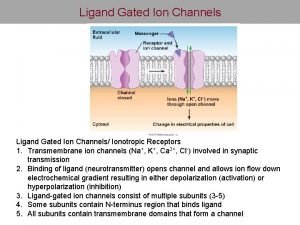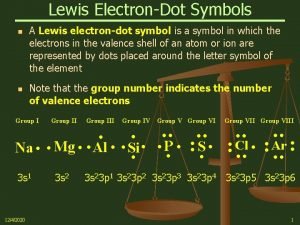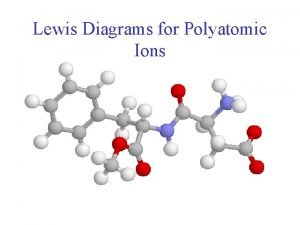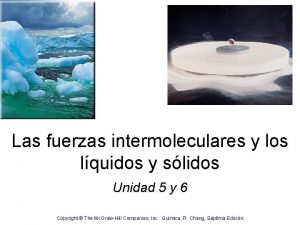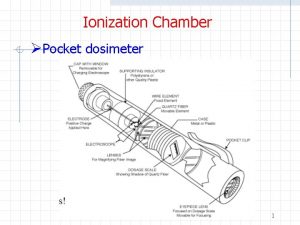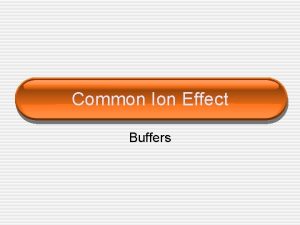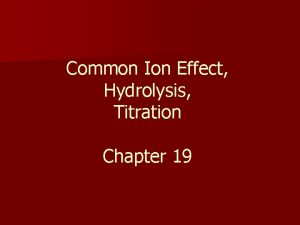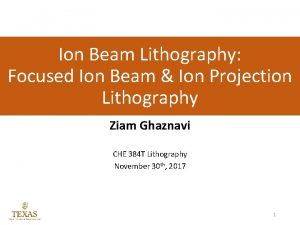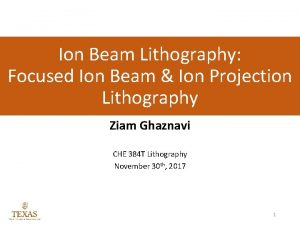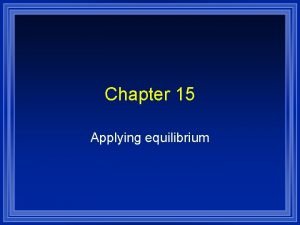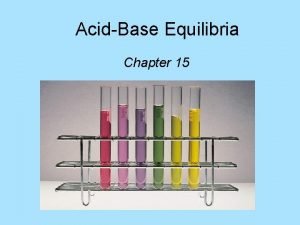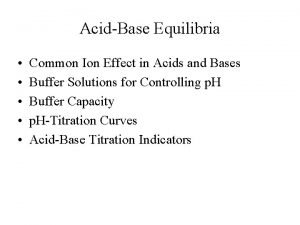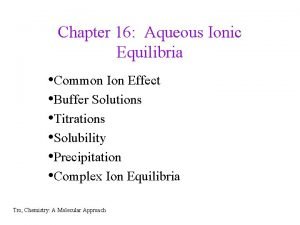COMMON ION EFFECT COMMON ION an ion common








































































- Slides: 72

COMMON ION EFFECT

COMMON ION an ion common with one in a system at equilibrium which places a stress on the equilibrium Common Ion

Uses of Common Ion Effect 1. control p. H of a weak acid or base 2. control formation of a precipitate

BUFFER Example Non-example A solution which resists a change in p. H when an acid or base is added consists of a weak acid or base and a salt containing a common ion of its conjugate

How does Le. Chatelier’s Principle explain the operation of a buffer?

Example of a buffer system CH 3 COOH + HOH CH 3 COO- + H 3 O+ Na. CH 3 COO(aq) Na+ + CH 3 COO-

Characteristics of a Good Buffer

1. operates over a narrow p. H range (< 1 p. H unit) 2. no reactions between buffers in a multiple buffer system 3. range can be extended using more than one buffer

Henderson-Hasselbalch Equation

Maximum buffering will occur when ratio is close to 1, or when p. H = p. Ka

1. What is the p. H of a 0. 20 M acetic acid solution?

Add 10. 0 m. L of 0. 20 M Na. OH to 50. 0 m. L of the preceding solution. What is the p. H?

Add 5. 0 g sodium acetate (MM 82. 05) to 500. m. L of the 0. 20 M acetic acid solution. What is the p. H?

Add 10. 0 m. L of 0. 20 M Na. OH to 50. 0 m. L of the preceding solution. What is the p. H?

2. Calculate the mass of ammonium chloride (MM 43. 6) needed to buffer 250. m. L of 2. 0 M ammonia to a p. H of 10.


TITRATION CURVES

Titration Curve A graphical history of a titration typically a plot of the p. H (dependent variable) and volume titrant (independent variable)

Uses of Titration Curves 1. determine equivalence point 2. determine number of ionization reactions 3. determine optimum buffer region 4. determine possible indicators

Shape of Titration Curve Strong acid - strong base Weak acid - strong base

Shape of Titration Curve

Shape of Titration Curve

Equivalence Point 1. Midpoint between points of inflection 2. Plot of the slope of each point of the curve against volume titrant (Dp. H/DV vs Vavg)

Number of Ionization Reactions CH 3 COOH - Na. OH H 2 C 2 O 4 - Na. OH



Optimum Buffer Region Area where the concentration of molecules and their conjugate ions are relatively high

Indicators Need to choose for each titration system Dependent on p. H at equivalence point

ACID-BASE INDICATORS

Acid-base indicators are weak Bronsted. Lowry compounds that are different colors in acid and base form.

Acid-base indicators are all large organic molecules. HIn <===> Color 1 + H In + Color 2

Phenolphthalein Colorless acid form, HIn

Phenolphthalein Pink base form, In-

The color change occurs at a different p. H for different indicators. The p. H at which the indicator changes color is dependent on the Ka of the indicator as a weak acid.

HIn <===> + H + In

Experiments have shown that the minimum amount of change of HIn <==> In that can be detected visually is


Thus, from the Henderson-Hasselbalch equation, one can select an appropriate indicator for a titration based upon the Ka of the indicator and the p. H at the equivalence point.

What is the p. H at the equivalence point of a titration of 25. 0 m. L each of 0. 10 M HCl and 0. 10 M Na. OH?

What is the p. H at the equivalence point of a titration of 25. 0 m. L each of 0. 10 M CH 3 COOH and 0. 10 M Na. OH?

Phenolphthalein -9 Ka = 1 x 10 p. H of perceptible color change?

SOLUBILITY EQUILIBRIA

Saturated Solution Maximum amount of solute dissolved in a specific volume of solvent at a specific temperature

Saturated Solution Equilibrium is established between a solid solute and ions from the solute

Super-Saturated Solution More than the normal maximum amount of solute is dissolved in a solution.

Question at a constant temperature, what is the difference in concentration of a saturated solution: (1 m. L vs 1 ML solution) (1 mg vs 1 kg solid)

The concentration of a saturated solution remains the same, no matter how much solid is present, as long as the temperature remains constant.

The “concentration” of a solid remains the same at a constant temperature.

By convention, equations for the formation of saturated solutions are written in the format solid <===> solution Ag. Cl(s) <===> Ag+ + Cl-

Ag. Cl(s) <===> + Ag + Cl

Ag. Cl(s) <===> + Ag + Cl

3. What is the solubility of silver chloride in water at 25 o. C? -10 (Ksp = 1. 6 x 10 )

4. What is the solubility of lead(II) bromide at o -6 25 C? (Ksp = 4. 6 x 10 )

6. What mass of nickel is dissolved in 100. m. L of saturated nickel(II) hydroxide? -16 (Ksp = 1. 6 x 10 ) What is the p. H of this solution?

Which is more soluble? Ag 2 CO 3 [Ksp = 8. 5 x 10 -13] or Ca. CO 3 [Ksp = 3. 4 x 10 -9]

SOLUBILITY ---ACIDITY ---PRECIPITATION

8. If 0. 581 gram of magnesium hydroxide (MM 58. 3) is added to 1. 00 L of water, will it all dissolve? (Ksp = 8. 9 x 10 -12) Below what p. H would the solution be buffered so that it does all dissolve?

9. Calculate the + concentration of NH 4 from ammonium chloride required to prevent the precipitation of Ca(OH)2 in a liter of solution that contains 0. 10 mole of ammonia and 0. 10 mole of calcium ion.

10. If 50. m. L of 0. 012 M barium chloride are mixed -6 with 25 m. L of 1. 0 x 10 M sulfuric acid, will a precipitate form? HINT: use the concentration quotient “Q” as we used it before

11. You have a aqueous solution of Zn 2+ and Pb 2+ both 0. 0010 M. Both form insoluble sulfides. Approximately what p. H will allow maximum precipitation of one ion and leave the other in solution? 12. [Ksp Zn. S = 2. 5 x 10 -22] 13. [Ksp Pb. S = 7 x 10 -29]

SOLUBILITY ---COMMON IONS ---COMPLEX IONS

12. Calculate the molar solubility of silver thiocyanate, Ag. SCN, in pure water and in 0. 010 M Na. SCN.

Complex Ion A charged species consisting of a metal ion surrounded by ligands

LIGAND An ion or molecule, acting as a Lewis base, attached to the central metal ion using the d-orbitals of the metal

Coordination Number The number of ligands attached to the central metal ion. 2, 4, or 6 are most common CN

Metal ions add ligands one step at a time. Ag+ + NH 3 <==> Ag(NH 3)+ Kf 1 = 2. 1 x 103 Ag(NH 3)+ + NH 3 <==> Ag(NH 3)2+ Kf 2 = 8. 2 x 103 where Kf = formation constant


You need to familiarize yourself with “typical” complex ions, Appendix K

Note that a formation constant reflects the stability of the complex.

13. Calculate the equilibrium constant for Ag. I(s) + 2 NH 3(aq) <===> + [Ag(NH 3)2] (aq) + I (aq)

14. Will 5. 0 m. L of 2. 5 M NH 3 dissolve 0. 0001 mole Ag. Cl?

15. A solution is prepared by adding 0. 10 mole Ni(NH 3)6 Cl 2 to 0. 50 L of 3. 0 M NH 3. Calculate the [Ni(NH 3)62+] and [Ni 2+] in the solution.
 Common ion effect example
Common ion effect example Saturated
Saturated Solubility product
Solubility product Common ion effect explained
Common ion effect explained Applications of common ion effect
Applications of common ion effect Common ion effect example
Common ion effect example Solubility product and common ion effect
Solubility product and common ion effect Common ion effect example
Common ion effect example Saturated
Saturated Solubility product and common ion effect
Solubility product and common ion effect Picture
Picture Reaction quotient vs equilibrium constant
Reaction quotient vs equilibrium constant Common ion effect practice problems
Common ion effect practice problems Common ion effect
Common ion effect Common ion effect
Common ion effect Ejemplo de fuerza ion ion
Ejemplo de fuerza ion ion Ejemplo de fuerza ion ion
Ejemplo de fuerza ion ion Dipolos instantaneos
Dipolos instantaneos Dipole induced dipole interaction
Dipole induced dipole interaction Diverse ion effect
Diverse ion effect Definition of solubility product constant
Definition of solubility product constant Chloride shift
Chloride shift Founder effect vs bottleneck effect
Founder effect vs bottleneck effect Marshallian demand function
Marshallian demand function Common ion solubility
Common ion solubility Common factors of 48 and 60
Common factors of 48 and 60 Common anode and common cathode
Common anode and common cathode Factor tree of 56
Factor tree of 56 Factors of 54
Factors of 54 Lcm of 4 8 and 16
Lcm of 4 8 and 16 Highest common factors and lowest common multiples
Highest common factors and lowest common multiples Ternary ionic compounds
Ternary ionic compounds Diacetyl monoxime reaction with urea
Diacetyl monoxime reaction with urea Hs- ion name
Hs- ion name Criss cross method definition
Criss cross method definition Feco3 cation and anion
Feco3 cation and anion Carbon dioxide ion
Carbon dioxide ion Tcs internal certification
Tcs internal certification Sputter ion pump working principle
Sputter ion pump working principle What are spectator ions
What are spectator ions How is positive ion formed
How is positive ion formed Zero order kinetics
Zero order kinetics What is ion trapping in pharmacology
What is ion trapping in pharmacology Aktivlik
Aktivlik Difference between affinity and ion exchange chromatography
Difference between affinity and ion exchange chromatography Pleur- prefix
Pleur- prefix Ion revenue meter
Ion revenue meter Potential of the glass electrode is given by
Potential of the glass electrode is given by Nick the camel
Nick the camel How to write polyatomic ions
How to write polyatomic ions Plyatomic ions
Plyatomic ions Ions meaning chemistry
Ions meaning chemistry An ion source is producing 6li ions
An ion source is producing 6li ions First pass effect
First pass effect Atomic radius of arsenic
Atomic radius of arsenic Carbonium ion rearrangement
Carbonium ion rearrangement Aluminum ion symbol
Aluminum ion symbol Hs- ion name
Hs- ion name Spectator ions examples
Spectator ions examples Stock system naming
Stock system naming Steps to naming ionic compounds
Steps to naming ionic compounds Periodic table monatomic ions
Periodic table monatomic ions Fintonal
Fintonal Medical terminology
Medical terminology Applications of mass spectrometry
Applications of mass spectrometry Transmembrane ligand gated ion channel
Transmembrane ligand gated ion channel Carbon monoxide lewis structure
Carbon monoxide lewis structure Hno2 lewis structure molecular geometry
Hno2 lewis structure molecular geometry Electron dot diagram of bromine
Electron dot diagram of bromine Cno- lewis structure
Cno- lewis structure Argon punto de fusion y ebullicion
Argon punto de fusion y ebullicion Arsenatni ion
Arsenatni ion Equivlaent
Equivlaent

